Seeing the Unseen: Untapping the True Cost of Our Food System
When purpose meets community, the atmosphere shifts — conversations deepen, ideas sharpen, and the room fills with momentum. That’s exactly what unfolded at our November Members Monthly Meetup at FellowSpace, delivered in collaboration with The Sustainable Food Foundation.
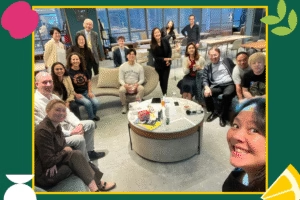
Happy faces all around at our in-person November Members Meetup at FellowSpace.
This was an afternoon shaped by clarity, curiosity, and the shared mission to rethink how our sector uses and values natural resources.
Why “Value Natural Resources” Hit Home
This month’s theme: Value Natural Resources came at precisely the right moment. With rising costs, evolving regulations, and consumers demanding more transparency than ever, resource use has moved from background conversation to strategic priority.
We opened with one grounding truth:
Water. Soil. Land. Energy. Biodiversity.
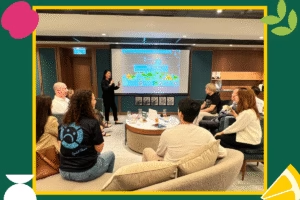
Kicking off a powerful conversation on why valuing natural resources matters now more than ever.
They shape everything: supply chains, menus, pricing, guest experience, and long-term viability. Yet these hidden inputs rarely show up in business decisions, and that gap is costing us.
A few numbers brought this reality into focus:
- The global food system accounts for almost one-third of total greenhouse gas emissions.
- 8–10% of emissions come directly from food loss and waste.
- And strikingly, 40% of all food produced goes uneaten.
This wasn’t about doom and gloom. It was about opportunity. The opportunity to redesign, rethink, and rebuild systems with impact and resilience in mind.
Making the Invisible Visible 🎤
The heart of our discussion centred on making natural resources visible because visibility unlocks action.
Attendees explored practical ways to embed resource awareness into real operations, from menu design to procurement:
- Building plant-rich menus that strengthen margins without sacrificing flavour
- Rethinking sourcing through seasonal, local, and lower-impact ingredients
- Reducing food waste to boost both sustainability and profitability
- Integrating water, land, and carbon metrics into purchasing decisions
- Using resource data as a strategic tool, not just a reporting requirement
The message was simple: Visibility drives better decisions and better business.
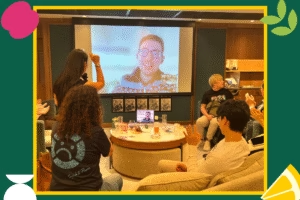
Matthew Isaacs joins us virtually to break down the future of carbon clarity in food.
Carbon Clarity With Matthew Isaacs
Our guest speaker, Matthew Isaacs, Co-Founder of My Emissions, brought the room straight into the reality of carbon transparency and why it matters now more than ever.
Matthew shared how carbon labelling is reshaping decisions across stadiums, delivery platforms, restaurants, and catering groups. One message landed particularly strongly:
He then unpacked the practical realities behind carbon reporting and where businesses often get stuck. Some of his standout insights included:
- Consistent labels shift behaviour – customers gravitate toward lower-carbon dishes when menus offer genuine choice. If every dish is an E, diners don’t have anywhere to go.
- The biggest barrier isn’t the science, it’s the data – kitchens struggle with recipe weights, supplier information, and inconsistent purchasing details. The science isn’t the challenge. It’s getting clean, accurate kitchen data.
- Carbon insights help redesign menus without losing creativity – swapping high-impact ingredients, optimising recipes, and using carbon labels to steer both chefs and diners toward better choices.
- Real-world impact is already happening – From UEFA stadiums to Just Eat trials, transparent carbon ratings are helping organisations redesign menus and reduce emissions at scale.
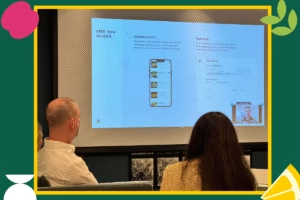
Diving into real-world examples of how UEFA is making carbon impact visible across menus.
These examples grounded the discussion in real application and highlighted how much opportunity the sector has when carbon becomes visible.
Four key takeaways from Matthew:
Prioritise internal action first
The highest reductions have happened before food is served or displayed on a menu.
Data is the biggest challenge
Data accuracy is a key term, but usually focuses on scientific data. In reality, business data (e.g. recipes or purchased weights) is the hardest and most important data to collect.
Joined up strategies work best
You can’t expect to see a reduction if every item on the menu has an ‘E’ carbon rating, or if the carbon ratings are very small / displayed as an after-thought.
Be patient!
Trials with Just Eat suggested people need to see carbon labels multiple times before taking action; UEFA is taking years to scale up.
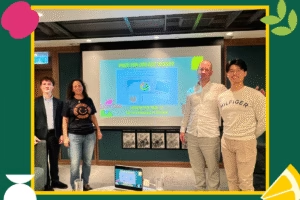
Celebrating our Carbon Emissions Game Show champion—proof that learning can be fun (and competitive!).
A Little Competition Never Hurts
Of course, no Future Green Meetup is complete without a dose of fun, and our Carbon Emissions Game Show delivered.
Two foods on screen, one question: Which has the bigger footprint?
The reactions? Gasps. Laughter. Cheers.
And several “Wait… WHAT?!” moments.
Who knew chocolate vs bananas could spark that much noise?.
Our winner (Chef Tom Brookes Burney from Compass Group HK) walked away with bragging rights and a free month of My Emissions access.
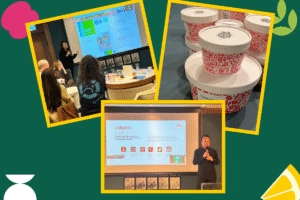
Community, Connection, and a Big Thank You
We wrapped the evening with warm conversations, shared insights, and some truly delicious refreshments.
A heartfelt thank you to our sponsors who made the meetup shine:
- FellowSpace — for hosting us in their warm, welcoming venue
- The Wine Guild — for a beautifully curated wine selection
- LMO Freshly Baked — for handcrafted bites to fuel the room
- Fresh Accounting — for their ongoing support of our Future Green community
Your collaboration helps turn meetups into meaningful shared experiences.
💚 See You Next Month (Online!)
While this was our last in-person meetup of the year, our learning journey continues.
We’ll be back next month online and back together in 2026.